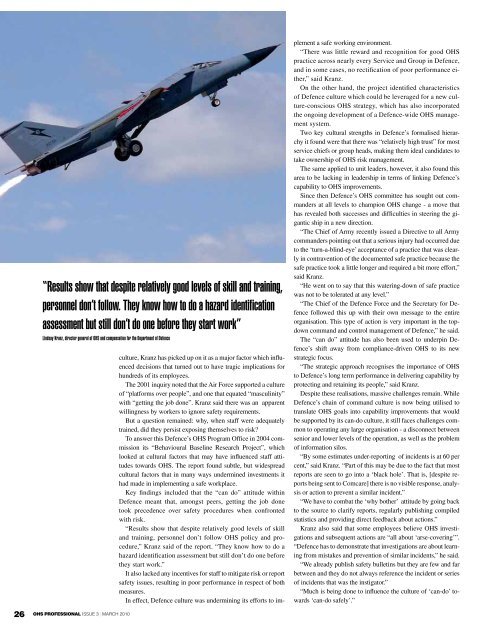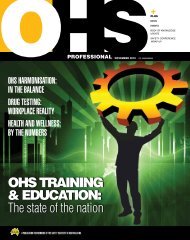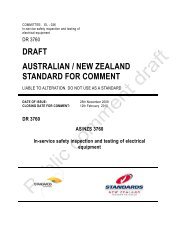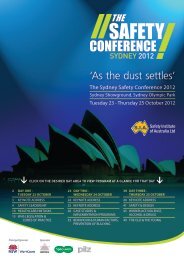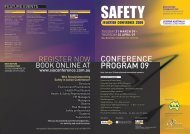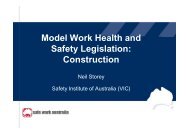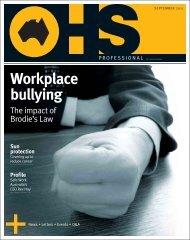Defence: overcoming its âcan Doâ culture unsW kills safety anD risk ...
Defence: overcoming its âcan Doâ culture unsW kills safety anD risk ...
Defence: overcoming its âcan Doâ culture unsW kills safety anD risk ...
Create successful ePaper yourself
Turn your PDF publications into a flip-book with our unique Google optimized e-Paper software.
26“results show that despite relatively good levels of skill and training,personnel don’t follow. they know how to do a hazard identificationassessment but still don’t do one before they start work”lindsay kranz, director general of ohs and compensation for the Department of <strong>Defence</strong>OHS PrOfeSSiOnaL ISSUE 3 | MARCH 2010<strong>culture</strong>, Kranz has picked up on it as a major factor which influenceddecisions that turned out to have tragic implications forhundreds of <strong>its</strong> employees.The 2001 inquiry noted that the Air Force supported a <strong>culture</strong>of “platforms over people”, and one that equated “masculinity”with “getting the job done”. Kranz said there was an apparentwillingness by workers to ignore <strong>safety</strong> requirements.But a question remained: why, when staff were adequatelytrained, did they persist exposing themselves to <strong>risk</strong>?To answer this <strong>Defence</strong>’s OHS Program Office in 2004 commission<strong>its</strong> “Behavioural Baseline Research Project”, whichlooked at cultural factors that may have influenced staff attitudestowards OHS. The report found subtle, but widespreadcultural factors that in many ways undermined investments ithad made in implementing a safe workplace.Key findings included that the “can do” attitude within<strong>Defence</strong> meant that, amongst peers, getting the job donetook precedence over <strong>safety</strong> procedures when confrontedwith <strong>risk</strong>.“Results show that despite relatively good levels of skilland training, personnel don’t follow OHS policy and procedure,”Kranz said of the report. “They know how to do ahazard identification assessment but still don’t do one beforethey start work.”It also lacked any incentives for staff to mitigate <strong>risk</strong> or report<strong>safety</strong> issues, resulting in poor performance in respect of bothmeasures.In effect, <strong>Defence</strong> <strong>culture</strong> was undermining <strong>its</strong> efforts to implementa safe working environment.“There was little reward and recognition for good OHSpractice across nearly every Service and Group in <strong>Defence</strong>,and in some cases, no rectification of poor performance either,”said Kranz.On the other hand, the project identified characteristicsof <strong>Defence</strong> <strong>culture</strong> which could be leveraged for a new <strong>culture</strong>-consciousOHS strategy, which has also incorporatedthe ongoing development of a <strong>Defence</strong>-wide OHS managementsystem.Two key cultural strengths in <strong>Defence</strong>’s formalised hierarchyit found were that there was “relatively high trust” for mostservice chiefs or group heads, making them ideal candidates totake ownership of OHS <strong>risk</strong> management.The same applied to unit leaders, however, it also found thisarea to be lacking in leadership in terms of linking <strong>Defence</strong>’scapability to OHS improvements.Since then <strong>Defence</strong>’s OHS committee has sought out commandersat all levels to champion OHS change - a move thathas revealed both successes and difficulties in steering the giganticship in a new direction.“The Chief of Army recently issued a Directive to all Armycommanders pointing out that a serious injury had occurred dueto the ‘turn-a-blind-eye’ acceptance of a practice that was clearlyin contravention of the documented safe practice because thesafe practice took a little longer and required a bit more effort,”said Kranz.“He went on to say that this watering-down of safe practicewas not to be tolerated at any level.”“The Chief of the <strong>Defence</strong> Force and the Secretary for <strong>Defence</strong>followed this up with their own message to the entireorganisation. This type of action is very important in the topdowncommand and control management of <strong>Defence</strong>,” he said.The “can do” attitude has also been used to underpin <strong>Defence</strong>’sshift away from compliance-driven OHS to <strong>its</strong> newstrategic focus.“The strategic approach recognises the importance of OHSto <strong>Defence</strong>’s long term performance in delivering capability byprotecting and retaining <strong>its</strong> people,” said Kranz.Despite these realisations, massive challenges remain. While<strong>Defence</strong>’s chain of command <strong>culture</strong> is now being utilised totranslate OHS goals into capability improvements that wouldbe supported by <strong>its</strong> can-do <strong>culture</strong>, it still faces challenges commonto operating any large organisation - a disconnect betweensenior and lower levels of the operation, as well as the problemof information silos.“By some estimates under-reporting of incidents is at 60 percent,” said Kranz. “Part of this may be due to the fact that mostreports are seen to go into a ‘black hole’. That is, [despite reportsbeing sent to Comcare] there is no visible response, analysisor action to prevent a similar incident.”“We have to combat the ‘why bother’ attitude by going backto the source to clarify reports, regularly publishing compiledstatistics and providing direct feedback about actions.”Kranz also said that some employees believe OHS investigationsand subsequent actions are “all about ‘arse-covering’”.“<strong>Defence</strong> has to demonstrate that investigations are about learningfrom mistakes and prevention of similar incidents,” he said.“We already publish <strong>safety</strong> bulletins but they are few and farbetween and they do not always reference the incident or seriesof incidents that was the instigator.”“Much is being done to influence the <strong>culture</strong> of ‘can-do’ towards‘can-do safely’.”


